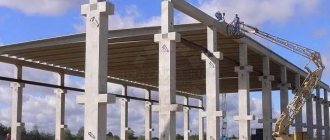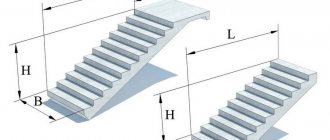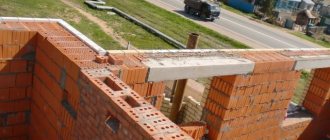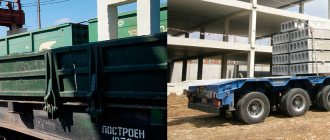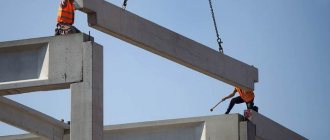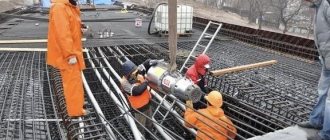- 1 Definition
- 2 Where are they used?
- 3 Advantages and disadvantages
- 4 Types
- 5 Production technology
- 6 Installation, repair and disposal of sleepers
- 7 Conclusion
During the existence of railways, supports for sleepers were made from various materials. There were stone ones, but stone is difficult to process, quickly cracks and becomes unusable. Durable wooden sleepers are tarred to protect against the negative effects of weather conditions. But after a while they also demanded either replacement or repair of the railway tracks. Today, reinforced concrete structures are rightfully considered the material of the future for the manufacture of supports for sleepers and foundations for buildings and structures. A foundation made of reinforced concrete sleepers is used for buildings of all possible complexity and number of storeys on any type of soil. However, it is worth considering that this product weighs a lot.
Definition
Reinforced concrete sleepers have the form of a rail support, the manufacture of which will require beams with varying sizes and cross-sectional shapes. Concrete rail supports are reinforced with steel wire, the diameter of which depends on the modification. When working with reinforced concrete sleepers, the following requirements are imposed on their production technology:
- preparing concrete mortar requires a uniform consistency;
- for the necessary transmission of stress, the material must have appropriate strength;
- When manufacturing products, they adhere to the exact dimensions and shapes that are important for reinforced concrete sleepers at the junction with the rails.
Return to contents
Construction of the foundation
A foundation made of reinforced concrete materials takes on the load from the building pressing on it and distributes it evenly over the entire soil surface. To create a support product, the following materials are required:
- Sleepers.
- Crushed stone and sand.
- Concrete.
- Metal staples, pins.
- Special equipment.
- Mastic, roofing felt.
- Shovels, tape measure, level.
- Pins.
The most popular type of foundation is strip foundation. It involves carrying out excavation work: clearing the area, which includes removing the turf layer and marking the future structure. After preparing the site, they begin digging trenches. Their depth should be 80-100 centimeters. And for a stronger foundation, they dig a width sufficient for three sleepers.
Next comes pouring the concrete. Before starting the procedure, a special formwork is made from the boards, which acts as a form. Reinforcing bars are installed inside this formwork and secured with wire. After the reinforcement layer is ready, it is poured with concrete. Then the entire structure is left alone for two weeks.
After this period, a layer of roofing material is laid on top of the concrete. Reinforced concrete sleepers are placed on it. Next, a reinforcing layer follows throughout the entire volume, and then everything is filled with concrete again.
Where are they used?
Nowadays, everyone wants to save money - used sleepers provide this opportunity when building your own home.
Reinforced concrete sleepers are used in the construction of foundations and railway tracks. Due to different natural operating conditions and varied mechanical loads on products, increased requirements are adhered to in the manufacture of reinforced concrete supports. This will increase the service life, which under favorable conditions of use will reach sixty years. Posts made using prestressed concrete outshine common wood posts everywhere due to their strength, durability and speed of installation.
Return to contents
Advantages and disadvantages
Reinforced concrete sleepers have the following advantages:
- long service life;
- sufficient resistance to the negative effects of environmental factors;
- no possibility of rotting during operation;
- resistance to various mechanical loads;
- low price category;
- installation and installation do not require large physical costs;
- do not require large maintenance costs during operation;
- Due to the fact that the width and length of the product are perfectly even, convenient transportation and unloading is ensured.
Reinforced concrete sleepers have the following disadvantages:
- The need for periodic inspection of railway tracks due to fatigue failure of a structure made of concrete.
- The sleeper weighs 0.27 tons, which means that manual installation of the products is impossible. Thus, due to the heavy weight, there is a need for specialized equipment. Concrete structures, unlike wood products, which weigh less, are mounted with special mechanisms - sleeper layers.
- The need to use elastic pads that reduce the rigidity of the product.
- Reinforced concrete sleepers have high electrical conductivity, which requires the use of insulation.
Return to contents
Application of reinforced concrete sleepers, technical characteristics, production
› Concrete products › Lintels
11.04.2019
Paying attention to the history of railways, you can see that there were several types of supports placed under the rails: stone slabs, wooden supports. Later, reinforced concrete sleepers became a reliable solution.
Reinforced concrete sleepers
Stone supports were difficult to process and cracks quickly appeared on them. Wooden sleepers were pre-tarred to protect them from negative atmospheric influences. However, after a short period of time they needed replacement.
A reinforced concrete sleeper is a beam having a variable cross-section. They are equipped with platforms for installing rails and have holes for connecting bolts for rail and sleeper fastenings. In the manufacture of products, pre-tensioning of reinforcement is used.
In the case of using prestressed material, it becomes possible to use smaller products, which leads to savings on concrete and reinforcement, transportation costs, and simplified installation.
Factories for the production of reinforced concrete products are located both in Moscow and in other cities of Russia. Reinforced concrete supports are in demand everywhere, and the demand for them is constantly growing.
Where are they used?
Reinforced concrete sleepers are often used in the process of constructing continuous railway tracks. In these cases, the distance between the rail joints is greater than the standard (25 m), which ensures a higher speed of railway transport and reduces operating costs.
Types
Reinforced concrete sleepers are divided into the following types, which depend on resistance to possible cracks, quality and the exact width, length and other dimensions of the product:
- First class support.
- Second grade support. It is characterized by a low degree of resistance to cracks, geometric dimensions do not require high requirements.
Depending on the type of rail fastening, there are the following types:
- Ш-1, with a separate type clamp-bolt connection, which is fixed to the support using a gasket and a bolt.
- Sh-2 of an inseparable type of fastening.
- Sh-3 are similar to Sh-2 supports, but differ in the method of fastening.
Reinforced concrete sleepers vary in class, the presence of electrical insulation and the type of reinforcement used. Reinforced concrete sleepers have differences in electrical insulation parameters:
- isolated;
- non-insulated, without insulating liners.
Return to contents
Production technology
Regardless of the area of use, reinforced concrete supports are made with the same strength and performance properties. There are four types of support manufacturing technology:
- Carousel type followed by mold removal. It consists of preparing the mixture and pouring it into molds, where it is further compacted. Remove the supports from the container after the solution has completely hardened and reached its maximum strength. For manufacturing, cassette structures are used, which accommodate six supports. To achieve the required adhesion and provide prestress, reinforcement is used, with the help of which the stress is transferred to the surface of the concrete. Upon completion of the product, the mold is removed and started for the next production.
- Linear. This type of manufacturing a reinforced concrete support involves a linear technology, which requires a conveyor on which the forms are placed in a certain sequence. The length of the installed forms reaches one hundred meters. The sides of the container are covered with specially designed devices, which are also capable of transmitting voltage to the reinforcement. As the mortar sets, stress is transferred to the surface of the concrete.
- Dismantling of forms with further stress. This type of manufacturing of reinforced concrete supports requires the installation of templates, with the help of which the location of steel reinforcement is determined. The containers are filled with concrete mortar and compacted. While the solution is setting, the pins are immersed in it. After some time, the mold and template are removed.
- Dismantling forms with prestressing is the same technology as when dismantling forms with further tension, only instead of pins, frames are used that provide a tension force in the product.
Return to contents
CONTROL METHODS
3.1. The compressive strength of concrete is determined according to GOST 10180 on a series of samples made from a concrete mixture of the working composition, stored under the conditions established by GOST 18105.
3.2. Frost resistance of concrete is determined according to GOST 10060.
3.3. The total tension force of the reinforcement is monitored using pressure gauge readings in accordance with GOST 22362 with a parallel connection of a recorder to record the tension force.
The tension force of individual reinforcement wires is measured by the transverse guy method according to GOST 22362.
3.4. To measure the linear dimensions of sleepers, as well as shells and edges of concrete, metal measuring instruments are used in accordance with GOST 13015. The depth of shells, as well as the gaps between the wires and concrete at the ends of the sleepers, are measured with a caliper with a pointed rod.
3.5. The distance between the thrust edges of the recesses of the under-rail platforms of different ends of the sleeper a is measured with a template applied simultaneously to both under-rail areas of the sleeper (Fig. 7).
The distances between the edges of the recess of one end of the sleeper a, between the axes of the holes for bolts a2 and from the axis of the hole to the thrust edge a3 are ensured by checking these dimensions on the form of metal plates that form recesses in the under-rail areas during the formation of sleepers.
3.6. The slope of the under-rail areas in the longitudinal and transverse directions to the sleeper axis (slope and propeller) is measured with an indicator applied simultaneously to both under-rail areas of the sleepers (Fig. 7 and 8).
DIMENSION ACCURACY CONTROL SCHEME a () AND PRODUCTS OF UNDER-RAIL SITES (i1 AND i2)
1 - template or indicator device
Crap. 7
SLEEP PROPELLER CONTROL SCHEME (i)
1 - measuring device
Crap. 8
3.7. Deviation from straightness of under-rail platforms is determined according to GOST 13015 by measuring the largest gap between the surface of the platform and the edge of a metal straight edge.
3.8. The depth of embedding of embedded washers into concrete is controlled by a device inserted into the sleeper channel and rotated 90° (Fig. 9).
The absence of concrete sagging in the sleeper channels, preventing installation and rotation of the bolt into the working position, as well as turning the bolt when screwing the nut, is checked with a embedded bolt in accordance with GOST 16017 with maximum positive deviations of the head dimensions. All four channels of the controlled sleeper are checked.
DIAGRAM OF A DEVICE FOR MEASURING THE DEPTH OF WASHERS
1 - handle; 2 — rod; 3 - scale; 4 - pointer; 5 — body; 6 - head
Crap. 9
3.9. The thickness of the protective layer of concrete over the top row of reinforcement is controlled in the middle of the sleeper using the method indicated in Fig. 10. It is allowed, by agreement between the manufacturer and the consumer, to control the thickness at the ends of the sleepers with a metal ruler.
3.10. The height of the sleeper is checked with a caliper in cross sections in the middle of each under-rail platform and in the middle of the sleeper.
SCHEME FOR MEASUREMENT OF THE THICKNESS OF THE PROTECTIVE LAYER OF CONCRETE ABOVE THE TOP ROW OF REINFORCEMENT IN THE MIDDLE OF THE SLEEPER
1 - rack; 2 - wire of the upper row of reinforcement
Crap. 10
3.11. Each sleeper selected for crack resistance tests is tested by static load sequentially in the under-rail and middle sections according to the diagrams shown in Fig. eleven.
The load is evenly increased with an intensity of no more than 1 kN/s (100 kgf/s) and brought to the control value indicated in the table. . This load is maintained constant for 2 minutes, after which the side surfaces on both sides of the sleeper at the tested section are inspected in order to detect visible cracks in the tension zone of the concrete. The surface of the concrete is not wetted. Illumination of the concrete surface is at least 3000 lux. To measure the length of cracks, a metal ruler is used, and for the width of cracks, a measuring magnifying glass is used in accordance with GOST 25706 with a division value of 0.05 mm.
SCHEME FOR TESTING SLEEPERS FOR CRACK RESISTANCE
in the under-rail section
in the middle section
1 - steel plate with a lower base slope of 1:20, size 250´100 mm, average thickness 25 mm; 2 — steel plate measuring 250´100´25 mm; 3 — rubber gasket measuring 250´100´10 mm; 4 - steel roller with a diameter of 40 and a length of 250 mm
Crap. eleven
3.12. The list of devices, indicators and templates for monitoring the geometric parameters of sleepers is given in Appendix 3.
3.13. All non-standardized measuring and testing instruments must undergo metrological certification in accordance with GOST 8.326.
Installation, repair and disposal of sleepers
The installation of railway tracks has the following features:
- Reinforced concrete supports and rails are installed on a pre-prepared surface, which consists of soil, sand and crushed stone. To preserve the sleepers during operation and the passage of trains over them, it is important to preserve the top layer of earth by installing sand strips.
- A reinforced concrete support weighs a lot, and an ordinary worker cannot lift such a weight of the structure; installation is carried out using mechanized equipment. This approach reduces the use of physical force and reduces the cost of installing products. The mechanized complex also reduces the time for laying the railway.
- To use reinforced concrete sleepers for fifty years, it is important to diagnose the tracks, which will identify deformations and breakdowns. The fastening elements are checked to ensure that there is no breakage, as this could lead to disruption of the fixation of the lining, which makes sounds as the train passes along the tracks.
- Failure to timely detect the failure of fasteners leads to the appearance of cracks and partial or complete breakage of the sleeper.
- When the service life of the product has expired or the reinforced concrete support has become unusable due to possible destruction, the sleeper is disposed of. Disposal occurs with a jaw crusher, with the help of which the product is crushed to the size of crushed stone of a small fraction or medium fraction. The recycled products are subsequently used to fill holes.
Repairing reinforced concrete sleepers involves identifying and eliminating defects and damage. Seal chips, potholes, sinkholes and cracks. When a breakdown is repaired, train traffic does not stop; the workplace is fenced off with a special signal sign. Major repairs are carried out between repairs, where sleepers do not need to be changed, repairs are carried out using track machine stations according to prepared individual projects and calculations. Repair of reinforced concrete supports is divided into:
- capital;
- average;
- lifting;
- reconstruction.
By type of top installation: laying on new crushed stone or on old crushed stone. To enhance the power and durability of tracks, in the process of repairing damaged parts, under-rail bases of various designs are used.
Return to contents
